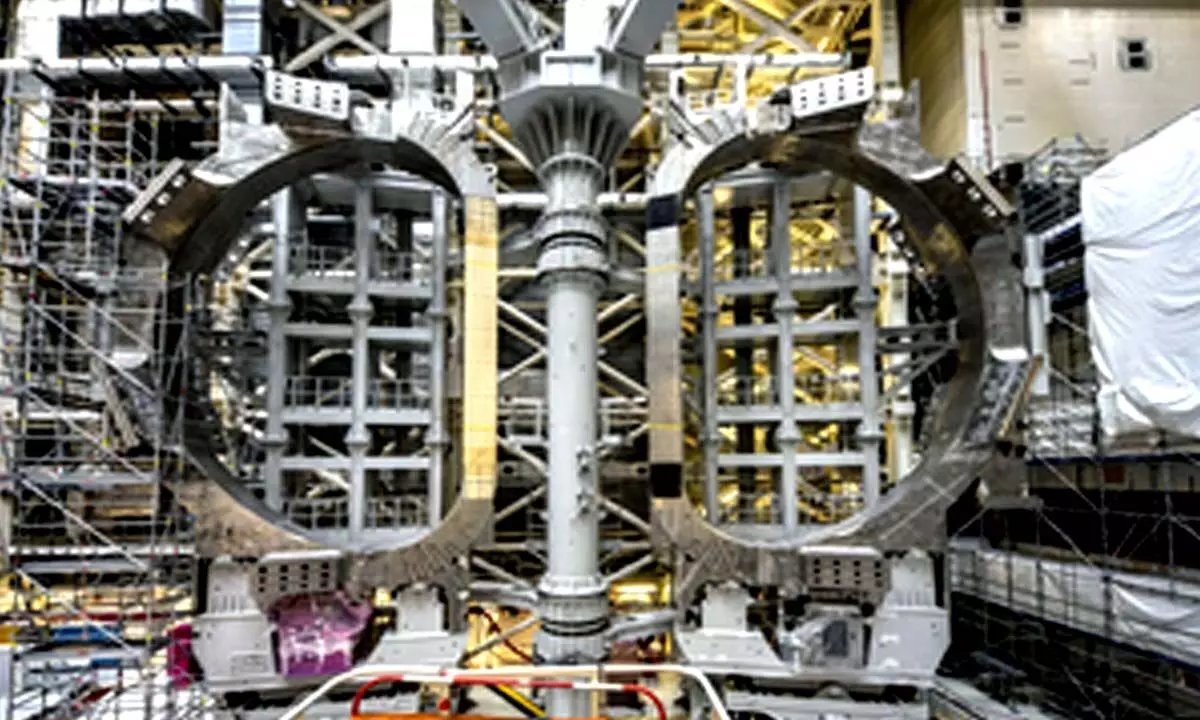ITER fusion energy project in France completes complex magnet system
Share :

After two decades of design, production, fabrication and assembly on three continents, the historic, multinational ITER fusion energy project, to which India is one of the partner nations
Cadarache (France): After two decades of design, production, fabrication and assembly on three continents, the historic, multinational ITER fusion energy project, to which India is one of the partner nations, on Monday celebrated the completion and delivery of its massive toroidal field coils from Japan and Europe.
Masahito Moriyama, Japan’s Minister of Science and Technology, and Gilberto Pichetto Fratin, Italy’s Minister of Environment and Energy Security, attended the ceremony with officials from other ITER members.
Nineteen gigantic toroidal field coils have been delivered to southern France. They will be key components in ITER, the experimental fusion mega-project that will use magnetic confinement to imitate the process that powers the sun and stars and gives earth light and warmth.
Fusion research is aimed at developing a safe, abundant, and environmentally-responsible energy source.
The ITER is a collaboration of more than 30 partner countries: the European Union, China, Japan, Korea, Russia and the US, besides India. Most of ITER’s funding is in the form of contributed components. This arrangement drives companies like Mitsubishi Heavy Industries, ASG Superconductors, Toshiba Energy Systems, SIMIC, CNIM, and many more to expand their expertise in the cutting-edge technologies needed for fusion.
The ITER is the first-of-a-kind global collaboration coming up in Saint-Paul-les-Durance, some 35 km north of Aix-en-Provence in southern France.
The D-shaped toroidal field coils will be placed around the ITER vacuum vessel, a donut-shaped chamber called a tokamak. Inside the vessel, light atomic nuclei will be fused together to form heavier ones, releasing enormous energy from the fusion reaction.
The fuel for this fusion reaction is two forms of hydrogen, deuterium and tritium (DT). This fuel will be injected as a gas into the tokamak. By running an electrical current through the gas, it becomes an ionized plasma -- the fourth state of matter, a cloud of nuclei and electrons.
The plasma will be heated to 150 million degrees, 10 times hotter than the core of the sun. At this temperature, the velocity of the light atomic nuclei is high enough for them to collide and fuse. To shape, confine, and control this extremely hot plasma, the ITER tokamak must generate an invisible magnetic cage, precisely conformed to the shape of the metal vacuum vessel.
The ITER uses niobium-tin and niobium-titanium as the material for its giant coils. When energized with electricity, the coils become electromagnets. When cooled with liquid helium to minus 269 degrees Celsius (4 kelvin), they become superconducting.
To create the precise magnetic fields required, ITER employs three different arrays of magnets. The 18 D-shaped toroidal field magnets confine the plasma inside the vessel. The poloidal field magnets, a stacked set of six rings that circle the tokamak horizontally, control the position and shape of the plasma.
At the centre of the tokamak, the cylindrical central solenoid uses a pulse of energy to generate a powerful current in the plasma. At 15 million amperes, ITER’s plasma current will be far more powerful than anything possible in current or previous tokamaks.
Ten coils were manufactured in Europe, under the auspices of ITER’s European Domestic Agency, Fusion for Energy (F4E). Eight coils plus one spare were made in Japan, managed by ITER Japan, part of the National Institutes for Quantum Science and Technology (QST).
Each completed coil is huge: 17 metres tall and nine metres across, and weighing about 360 tons.
The toroidal field coils will operate together, in effect, as a single magnet: the most powerful magnet ever made.
They will generate a total magnetic energy of 41 gigajoules. ITER’s magnetic field will be about 250,000 times stronger than that of the earth.
“The completion and delivery of the 19 ITER toroidal field coils is a monumental achievement,” said Pietro Barabaschi, ITER Director-General. “We congratulate the member governments, the ITER domestic agencies, the companies involved, and the many individuals who dedicated countless hours to this remarkable endeavour.”
The plant at ITER will produce about 500 megawatts of thermal power. If operated continuously and connected to the electric grid, that would translate to about 200 megawatts of electric power, enough for about 200,000 homes.
A commercial fusion plant will be designed with a slightly larger plasma chamber, for 10-15 times more electrical power. A 2,000 megawatt fusion power plant, for example, would supply electricity for 2 million homes.
India contributes through the Gujarat-based Institute for Plasma Research by manufacturing major components of the plasma chamber where the fusion reactions are going to take place for the first time in 2025.
Fusion power plants are carbon-free; they release no CO2.














